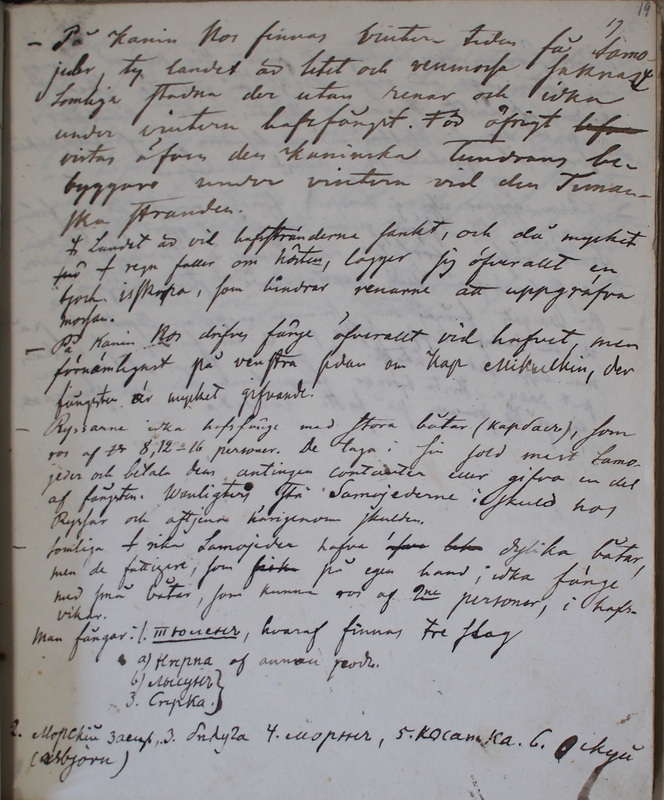Ethnographiska, historiska och statistiska anmärkningar. 019
Title
Description
| På Kanin Nos finnas vinter-tiden få Samojeder, ty landet är litet och renmossa saknas. «Landet är vid hafsstränderna sankt, och då mycket snö l. regn faller om hösten, lägger sig öfverallt en tjock isskorpa, som hindrar renarne att uppgräfva mossan.» |
There are few Samoyeds on Kanin Nos during the wintertime because the land is small and there is no reindeer moss. |
|
Somliga stadna der utan renar och idka |
Some stay there without reindeer and practise sea fishing during the winter. The rest of the residents of the Kanin tundra stay on the Timan shore during the winter. |
|
På Kanin Nos drifves fånge öfverallt vid hafvet, men |
At Kanin Nos, they hunt everywhere in the sea, but mainly on the left-hand side of Cape Mikulkin, where the catch is very rewarding. |
|
Ryssarna idka hafsfånge med stora båtar
(карбасъ),
somRu karbas TN харбас is a Russian, especially Pomor vessel with oars and sails. They were used both as river and sea vessels for fishing and hunting sea mammals. (Lepëchin 1805: 10–11; ESBE 1895: 472-473 (karbasʹʹ))
ros af 8, 12-16 personer. De taga i sin sold mest Samo- jeder och betala dem antingen contacter eller gifva en del af fångsten. Wanligtvis stå Samojederne i skuld
hosSeveral sources mention the incurring of debts among the indigenous peoples, including the Nenets, in relation to taxation and trade. The indigenous peoples themselves had been complaining about misconduct since at least 1682. On commercial fishing, see note [017. Mezen merchants]. (Schrenk 1848: 487-492; Islavin 1847: 54–66; Lehtisalo 1956: LVIII–LIX; 1959: 87–88; Forsyth 1992: 158–163; Alekseev (ed.) 2010: 101; Latkin: 106–107; 121–122)
Ryssar och aftjena härigenom skulden. |
The Russians engage in sea hunts with large boats (karbasʹʹ), which are rowed by eight or 12-16 people. They hire mostly Samoyeds and pay them either in cash or by giving them a part of the catch. Usually, the Samoyeds are in debt to the Russians and they are settling their debt. |
|
Somliga rika Samojeder hafva dylika båtar, |
Some rich Samoyeds have such boats, but the poorer ones, who fish on their own, practise sea hunting with small boats that are rowed by two men in the bays. |
| Man fångar: 1. тюленъ, hvaraf finnas tre slag a) нерпа af annan родъ b) лысунъ c) серка.
Ru serka ʻGreenland seal’ (Phoca groenlandica Erxleben). Young Greenland seals with gray skin are called serka in Russian.
|
They hunt: 1. seal, of which there are three kinds: a) ringed seal |
| 2. мосркiй заецъ, 3. белуга 4. моржъ, 5.
косатка
6.
Ru kosatka ʻorca’ (Orcinus orca)
Оскуй
Oskuj derives from the Komi ош ʻbear’. TN сэр” варк. See [Kyvkud]
(isbjörn) |
2. bearded seal, 3. whale 4. walrus, 5. orca. 6. Oskuj (polar bear) |

